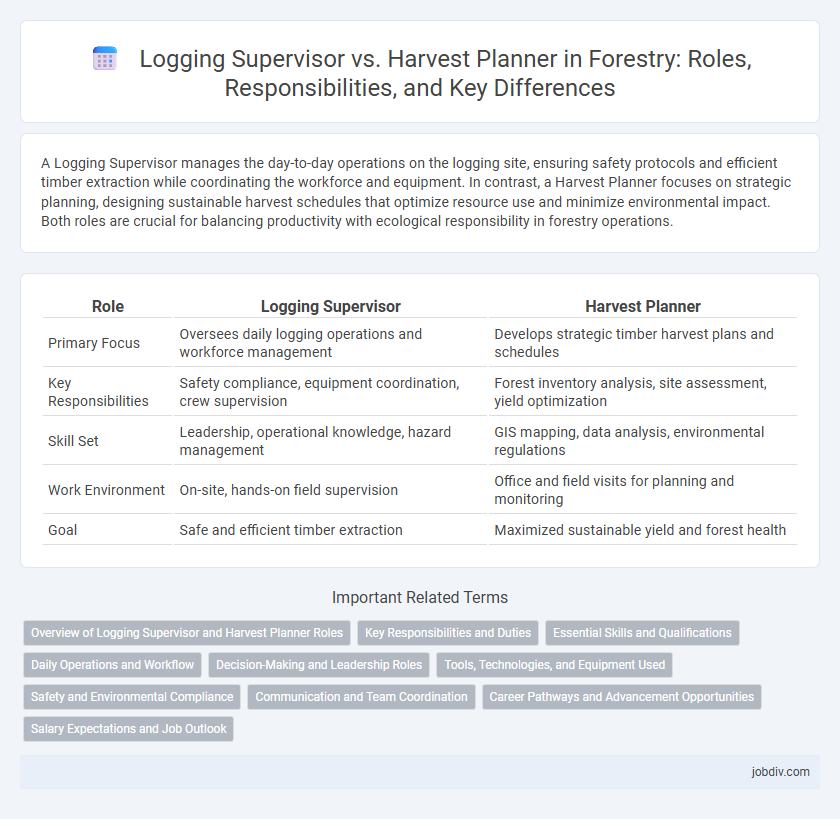A Logging Supervisor manages the day-to-day operations on the logging site, ensuring safety protocols and efficient timber extraction while coordinating the workforce and equipment. In contrast, a Harvest Planner focuses on strategic planning, designing sustainable harvest schedules that optimize resource use and minimize environmental impact. Both roles are crucial for balancing productivity with ecological responsibility in forestry operations.
Table of Comparison
| Role | Logging Supervisor | Harvest Planner |
|---|---|---|
| Primary Focus | Oversees daily logging operations and workforce management | Develops strategic timber harvest plans and schedules |
| Key Responsibilities | Safety compliance, equipment coordination, crew supervision | Forest inventory analysis, site assessment, yield optimization |
| Skill Set | Leadership, operational knowledge, hazard management | GIS mapping, data analysis, environmental regulations |
| Work Environment | On-site, hands-on field supervision | Office and field visits for planning and monitoring |
| Goal | Safe and efficient timber extraction | Maximized sustainable yield and forest health |
Overview of Logging Supervisor and Harvest Planner Roles
Logging Supervisors oversee on-site logging operations, ensuring safety compliance, crew coordination, and efficient timber extraction. Harvest Planners focus on designing sustainable harvest strategies, optimizing resource allocation, and integrating environmental considerations into operational plans. Both roles are crucial for balancing productivity with ecological impact in forestry management.
Key Responsibilities and Duties
A Logging Supervisor oversees daily logging operations, ensuring safe machinery use, worker compliance with environmental regulations, and efficient timber extraction. In contrast, a Harvest Planner develops strategic plans for sustainable forest harvesting, optimizing yield while minimizing ecological impact through detailed site assessments and schedule coordination. Both roles require expertise in forestry management, but the supervisor focuses on field execution, whereas the planner emphasizes long-term resource optimization and regulatory adherence.
Essential Skills and Qualifications
A Logging Supervisor requires strong leadership, safety management, and hands-on operational skills to oversee timber harvesting activities and ensure compliance with environmental regulations. A Harvest Planner must possess advanced knowledge of forest inventory analysis, GIS mapping, and resource allocation to strategically plan efficient and sustainable timber harvests. Both roles demand expertise in forestry principles and strong communication abilities, but the Logging Supervisor emphasizes field execution while the Harvest Planner focuses on strategic planning and optimization.
Daily Operations and Workflow
A Logging Supervisor coordinates daily operations on-site, managing crew activities, equipment, and safety protocols to ensure efficient timber extraction. A Harvest Planner focuses on pre-harvest planning, optimizing workflow by designing harvest schedules and integrating environmental considerations with resource management. Both roles require strong communication to align field execution with strategic timber production goals.
Decision-Making and Leadership Roles
Logging supervisors oversee on-site operations, ensuring safety compliance and efficient resource extraction by making real-time decisions to address environmental and logistical challenges. Harvest planners develop strategic plans for timber extraction, analyzing forest inventory data and environmental impact to optimize sustainability and productivity. Both roles require strong leadership, with supervisors managing daily crews and planners coordinating multi-disciplinary teams to align forestry objectives with regulatory requirements.
Tools, Technologies, and Equipment Used
Logging Supervisors primarily utilize GPS mapping systems, real-time communication devices, and safety monitoring software to coordinate on-site operations and ensure compliance with environmental regulations. Harvest Planners rely on advanced Geographic Information Systems (GIS), drone technology for aerial surveys, and data analytics software to design efficient timber extraction plans and optimize resource allocation. Both roles employ heavy machinery like feller bunchers, skidders, and loaders, but Logging Supervisors focus more on operational tools, while Harvest Planners emphasize planning and analytical technologies.
Safety and Environmental Compliance
Logging supervisors prioritize onsite safety by enforcing protocols that protect workers from hazards such as equipment accidents and falling trees, while ensuring compliance with environmental regulations like sustainable harvesting and erosion control. Harvest planners focus on designing efficient timber extraction schedules that minimize ecological impact by integrating environmental assessments and habitat preservation into operational plans. Both roles are critical for maintaining workplace safety standards and adherence to federal and state forestry regulations like the Occupational Safety and Health Administration (OSHA) and the Environmental Protection Agency (EPA) guidelines.
Communication and Team Coordination
Logging Supervisors ensure effective communication on-site by directing crew activities and addressing safety protocols in real time, which enhances operational efficiency and worker safety. Harvest Planners coordinate with multiple stakeholders, including Logging Supervisors and environmental analysts, to develop sustainable timber extraction schedules and resource allocation strategies. Strong team coordination between both roles optimizes forest yield while minimizing ecological impact and logistical conflicts.
Career Pathways and Advancement Opportunities
Logging Supervisors typically advance through hands-on experience managing field operations, moving towards senior supervisory or forestry management roles. Harvest Planners often progress by developing expertise in GIS technology and resource management, leading to strategic planning or sustainability consultancy positions. Both career paths offer advancement opportunities in forestry project management, environmental compliance, and leadership within timber companies or government agencies.
Salary Expectations and Job Outlook
Logging supervisors typically earn an average annual salary ranging from $50,000 to $70,000, influenced by experience and regional demand, while harvest planners command slightly higher salaries, averaging between $60,000 and $80,000 due to their strategic role in forest resource management. The job outlook for logging supervisors remains steady with moderate growth expected as the timber industry balances environmental regulations with operational efficiency. Harvest planners face strong growth prospects driven by increased emphasis on sustainable forestry practices and advanced planning technologies that optimize timber yield and environmental compliance.
Logging Supervisor vs Harvest Planner Infographic

 jobdiv.com
jobdiv.com